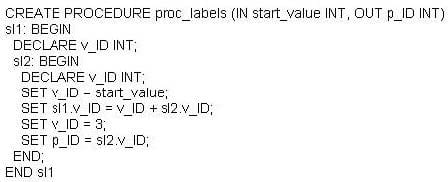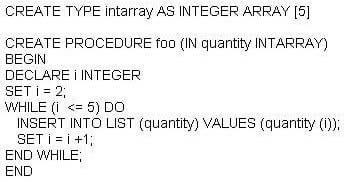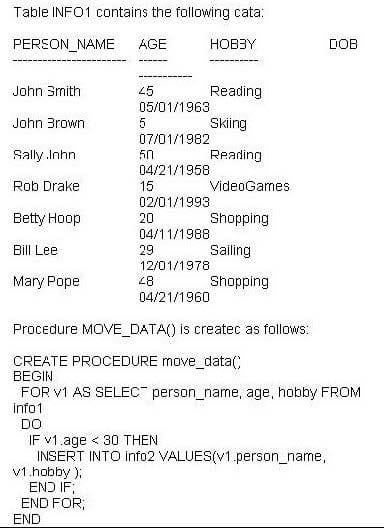C2090-545 Online Practice Questions and Answers
In the stored procedure below:

What will the value of the P_ID parameter be if the procedure is invoked and a value of 2 is specified forthe START_VALUE parameter?
A. 1
B. 2
C. 3
D. 4
Which statement can be used to define variable that can beshared between procedures?
A. DECLARE my_gl_var INTEGER DEFAULT 1
B. CREATE OR REPLACE VARIABLE my_gl_var INTEGER
C. DEFINE GLOBAL VARIABLE my_gl_var INTEGER
D. CREATE GLOBAL VARIABLE my_gl_var
Which statement is true about the data types VARCHAR and VARCHAR2?
A. The VARCHAR data type cannot be used with a database thathas been created in Oracle compatibility mode.
B. The VARCHAR2 data type treats empty strings as null; the VARCHAR data type treats empty strings as not null with zero length.
C. The VARCHAR2 data type length is limited to 2000 bytes; the VARCHAR data type length can be up to 32K.
D. The VARCHAR2 data type cannot be used in a database that has not been created in Oracle compatibility mode.
Using Optimistic Locking, both Transaction1 and Transaction 2 have read the same row including the RID_BIT and ROW CHANGE TOKEN values. Transaction 1 updates the row after ensuring that the row has not changed after the previous SELECT by adding a RID_BIT and ROW CHANGE TOKEN predicate to the UPDATE statement. Transaction 2 now tries to update that same row using the same predicate as transaction 1.
What will be the result?
A. The row will be found with the same ROW CHANGE TOKEN. Transaction 2 will now insert its values replacing those of transaction 1.
B. The row will be found with a different ROW CHANGE TOKEN and Transaction 2 will overwrite the values set in transaction 1.
C. The row will not be found because the value of the ROW CHANGE TOKEN has changed in regard to the UPDATE of transaction 1. Transaction 2 has to retry in order to retrieve the current data.
D. The row will not be found because the value of the ROW CHANGE TOKEN has changed in regard to the UPDATE of transaction 1. Transaction 2 will complete with an insert of a new row.
Which of the following steps are required to debug a stored procedure using IBM Data Studio?
A. Deploy the stored procedure from the data development project, debug the stored procedure.
B. Debug the stored procedure from the Data Source Explorer.
C. Deploy the stored procedure from the data development project, choose option for debugging and then debug.
D. Debug the stored procedure from the IBM Data Studio command line console.
Given the following statement: How many values are inserted in to the array called quantity?

A. 1
B. 2
C. 3
D. 4
Which of the following is the simplest way to define a recordwith fields corresponding to all of the columns that are fetched from a cursor or cursor variable?
A. Using the VARRAY attribute
B. Using the READ FROM CURSOR attribute
C. Using the %ROWTYPE attribute
D. Using the %CURSOR attribute
Click the Exhibit button.

How many rows will be in table INFO2 after the procedure MOVE_DATA shown in the exhibit is executed?
A. 0
B. 4
C. 5
D. 7
